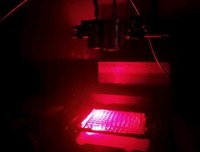To diagnose (and treat) a tumour, we could start by “listening” to it
A research team coordinated by scientists at the University of Bologna has developed a groundbreaking system that exploits the photoacoustic effect, which could not only allow cancer cells to be identified more accurately, but could also assist in their elimination.

Exploiting the photoacoustic effect, which allows light energy to be transformed into sound waves in order to identify and selectively target cancer cells. This solution was suggested by a research group led by academics at the University of Bologna.
The results of the study, which were published in the journal Advanced Functional Materials, show how a special carbon-based molecule called “fullerene” could be used to create a useful tool for diagnosing and treating tumours.
‘Fullerene is able to augment the diagnostic potential of photoacoustic microscopy by significantly increasing its spatial resolution, both when looking at the whole organ and when analysing it at a subcellular level,’ explains Matteo Calvaresi, professor at the “Giacomo Ciamican” Department of Chemistry, who coordinated the research. ‘This study therefore paves the way for using the photoacoustic effect in medical diagnosis , which would allow us to detect individual cancer cells using new contrast agents.’
In fact, many of today’s medical imaging systems use light waves. However, the propagation of light through biological tissues is weakened by scattering phenomena, resulting in a loss of image resolution, which makes it more difficult to see the deeper tissues. Instead, systems that produce images using the photoacoustic effect can offer great advantages, since sound can easily pass through the body’s tissues, and this applies to both incoming and outgoing sounds.
In fact, some materials emit acoustic waves when hit by very fast pulses of light. By selecting the appropriate frequency, an expansion and contraction effect in the material is produced, which in turn generates a detectable sound wave. One of these materials is fullerene: a spherical carbon-based molecule with a shape similar to that of a football and which, thanks to its special structure, is capable of producing an extremely intense audio signal.
But there is a problem: fullerene is completely insoluble in water, which up to now has prevented its properties from being exploited for biomedical applications. Researchers at the University of Bologna began looking for a solution by working together with a research team from the Centre for Translational Cancer Research (TranslaTUM) in Munich (Germany), led by Vasilis Ntziachristos, one of the inventors of photoacoustic microscopy.
‘We overcame the obstacle by resorting to an old, yet effective, trick: that of the Trojan horse, namely by hiding fullerene within a natural protein,’ says Matteo Di Giosia, a researcher at the University of Bologna and the study’s first author. ‘This approach allows us to solve two problems at once: the insolubility of fullerene in a physiological environment and its poor biocompatibility which, instead, are guaranteed by the selected protein.’
The identified solution is meant to enhance the features of medical diagnostic systems, which will be able to penetrate deeper into the tissues, thus allowing for more accurate images. However, fullerene could do more than that: for instance, it could also be used for so-called cancer phototherapy by creating phototheranostic platforms. This is a groundbreaking treatment that could not only help to identify cancer cells, but also to eliminate them using light.
‘The next step will be to introduce fullerene molecules selectively into cancer cells only,’ explains Matteo Calvaresi. ‘The idea we are working on is the use of viral vectors capable of selectively “infecting” only cancer cells. In this way, we could exploit the selective ability of viruses that have been modified in the laboratory to target overexpressed receptors on the membrane of cancer cells.’ If these further studies prove successful, they will be followed by a clinical trial.
Published in the journal Advanced Functional Materials under the title “A Bio-Conjugated Fullerene as a Subcellular-Targeted and Multifaceted Phototheranostic Agent”, the paper was co-authored by a research group from the University of Bologna, in collaboration with scientists from the “Aldo Moro” University of Bari, the CNR of Bologna and TranslaTUM (Germany). This research was made possible thanks to the Synergy and NanoPhage projects, sponsored by the AIRC Foundation for Cancer Research and active at the NanoBio Interface Lab of the “Giacomo Ciamican” Department of Chemistry of the University of Bologna.
